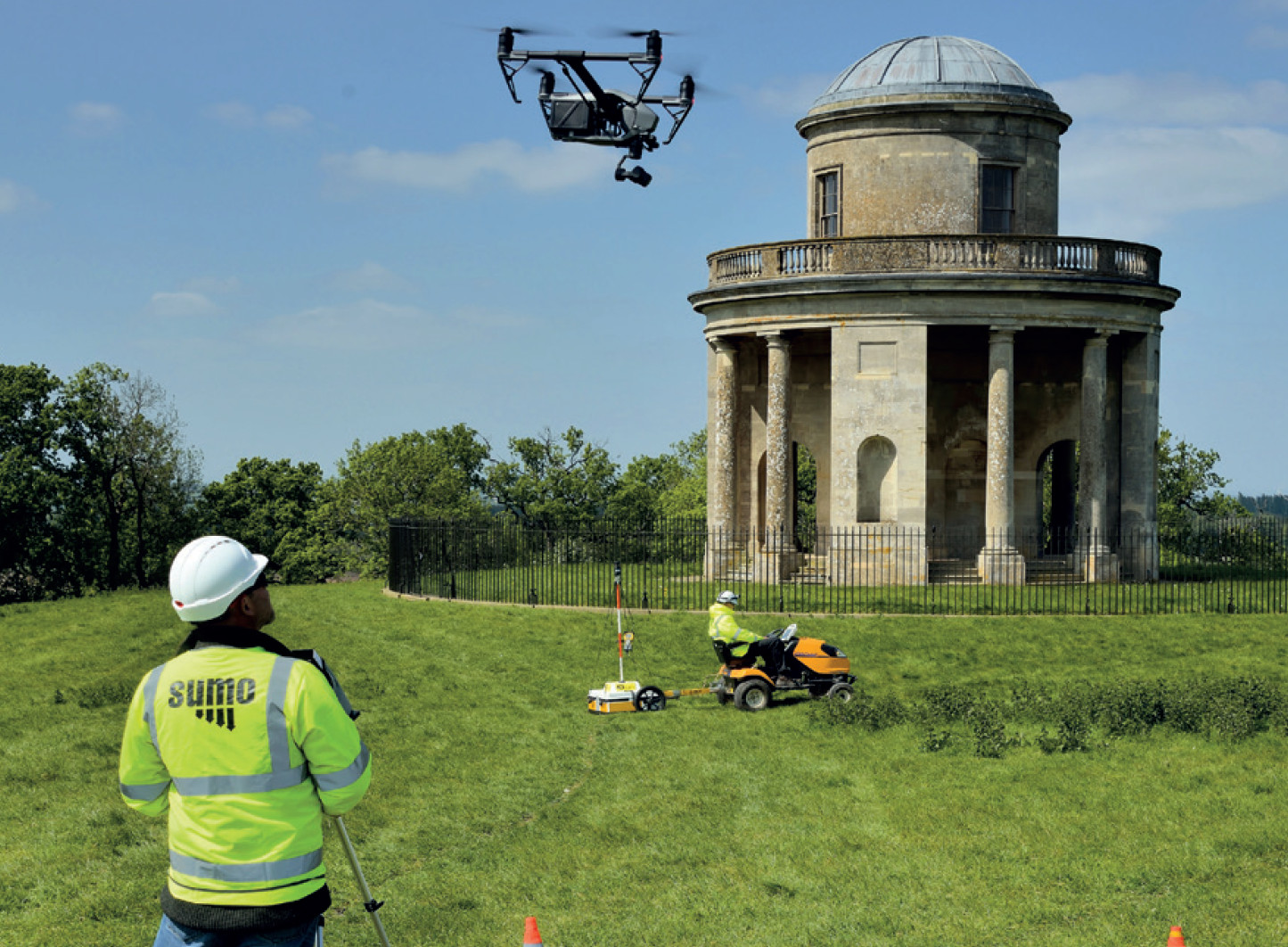Building archaeology and conservation
Technological advancement and rapid professionalisation, and even entire new branches of the profession, have brought new ways for archaeologists to investigate, analyse and interpret.

|
| A DJI Inspire 2 drone carrying out a microtopographic survey via photogrammetry, while a MALÅ Imaging Radar Array (MIRA) high-density, ground-penetrating radar (GPR) survey is undertaken below (Photo: Richard Fleming/Sumo Aerial Surveys). |
In 2017 The Institute of Historic Building Conservation (IHBC) signed a memorandum of understanding (MoU) with the Chartered Institute for Archaeologists (CIfA). This agreement set out the institutes’ ambition to work more closely together, understand each other better, and advance shared interests and complementary working practices, while supporting mutual recognition of specialist expertise.
CIfA is a leading professional body in the archaeological sector, promoting professional standards and strong ethics in archaeological practice, and championing professionalism in the study and care of the historic environment. It accredits archaeologists and archaeological practices.
Archaeology can be defined as the study of physical evidence of the human past, whether buried, built or underwater. This ranges from investigation of landscape, through settlements, building fabric, plan form and space, features, artefacts and biological remains.
The archaeological profession has expanded almost beyond recognition in the past 50 years. The profession’s wide array of technical branches and specialisms include archival work, archaeobiology, collections management, forensic, geophysics, marine, and many more. The majority of archaeologists work for private-sector contractors within the planning system. Others work in research institutions, museums and local authorities (where they provide advice to planners, or maintain historic environment records and other databases, and are subject to many of the same pressures as conservation officers). Many archaeologists work in laboratories, analysing such things as bones, botanical remains, microscopic remains found in soil and the plaque on ancient teeth.
Archaeologists working in or with museums may employ skills shared across that industry, and they apply specialist approaches to archaeological collections management and interpretation. And, of course, some archaeologists work in the literal ‘field’, with trowel, trench and tape measure as the basic toolkit. They are supported by geophysical and aerial survey techniques, experimental methods to test past technologies, and myriad approaches to interpreting it to the public. Archaeology has a strong history of voluntary and community work, and many archaeologists work in a voluntary capacity through local societies or with community groups.
The archaeology of buildings is a well-established and distinct specialism. More than 900 of CIfA’s 3,500 members are in the institute’s buildings archaeology group, being drawn from commercial and public sectors, and national and local heritage organisations. Buildings archaeologists apply archaeological principles of systematic recording, analysis and interpretation to standing buildings. They may be engaged to establish the character, type, plan form, function and historical development of a building.
This work is carried out through a combination of desk-based and visual processes, and a variety of techniques, from scientific methods such as dendrochronological dating, spatial analysis, photographic survey or digital modelling techniques, to the more traditional visual analysis, measuring and drawing, intrusive interventions and excavation. The products of this work include historic building recording reports and photographic surveys produced to compile a lasting record where material is due to be lost, to inform a conservation strategy or to fulfil a planning condition.
Having received a royal charter as an institute in 2014, CIfA now intends to petition the Privy Council to enable it to award a ‘chartered archaeologist’ accreditation. The institute is delighted that the IHBC has recorded its formal support for the initiative.
Indeed, CIfA welcomes the fact that, through the MoU, chartered archaeologists who also work with historic buildings have their archaeological expertise recognised by the IHBC, just as the MoU means that IHBC members have their built and historic environment conservation expertise recognised by CIfA.
To develop their relationship, the IHBC and CIfA are each continuing to offer a free one-year taster membership of the other institute to help colleagues experience the respective disciplines and support at first hand. For details of how to take up the CIfA membership and conference offers, see http://www.archaeologists.net/join/IHBC
This article originally appeared as ‘Parallel professions: archaeology and conservation’ in IHBC’s Context 153, published in March 2018. It was written by Rob Lennox, policy advisor at the Chartered Institute for Archaeologists.
--Institute of Historic Building Conservation
Related articles on Designing Buildings Wiki
- Archaeological officer.
- Archaeology.
- Archaeology and construction.
- Building archaeology.
- Conservation area.
- Conservation officer.
- Conservation.
- IHBC articles.
- Listed building.
- Recording old industrial sites.
- Society for the Protection of Ancient Buildings.
- The Archaeology Data Service.
- The Institute of Historic Building Conservation.
IHBC NewsBlog
SAVE celebrates 50 years of campaigning 1975-2025
SAVE Britain’s Heritage has announced events across the country to celebrate bringing new life to remarkable buildings.
IHBC Annual School 2025 - Shrewsbury 12-14 June
Themed Heritage in Context – Value: Plan: Change, join in-person or online.
200th Anniversary Celebration of the Modern Railway Planned
The Stockton & Darlington Railway opened on September 27, 1825.
Competence Framework Launched for Sustainability in the Built Environment
The Construction Industry Council (CIC) and the Edge have jointly published the framework.
Historic England Launches Wellbeing Strategy for Heritage
Whether through visiting, volunteering, learning or creative practice, engaging with heritage can strengthen confidence, resilience, hope and social connections.
National Trust for Canada’s Review of 2024
Great Saves & Worst Losses Highlighted
IHBC's SelfStarter Website Undergoes Refresh
New updates and resources for emerging conservation professionals.
‘Behind the Scenes’ podcast on St. Pauls Cathedral Published
Experience the inside track on one of the world’s best known places of worship and visitor attractions.
National Audit Office (NAO) says Government building maintenance backlog is at least £49 billion
The public spending watchdog will need to consider the best way to manage its assets to bring property condition to a satisfactory level.
IHBC Publishes C182 focused on Heating and Ventilation
The latest issue of Context explores sustainable heating for listed buildings and more.
















